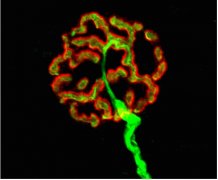articles

A new study of the human nervous system could provide a breakthrough in our understanding of the causes of movement disorders.
Nerve cell findings may aid understanding of movement disorders
A pioneering study of the human nervous system could provide a breakthrough in our understanding of the causes of movement disorders, such as motor neurone disease.
The new study has investigated a type of cell connection that allows electrical and chemical messages to flow from nerve to muscle cells, enabling motion.
The results give a fresh insight into conditions where these connections break down, such as motor neurone disease, which can lead to severe problems with walking and reflexes.
Researchers, including Professor Christian Soeller from the University of Exeter’s Living Systems Institute, used cutting-edge imaging to study 3000 of these cell connections – known as neuromuscular junctions (NMJ) – from tissue gifted by 20 donors undergoing unrelated leg surgery.
The study highlighted previously unknown differences in the structure and make up of human NMJs compared with those of mice and rats, which are routinely used in studying neuromuscular diseases. Surprisingly, human NMJs were much smaller and frailer than those found in other mammals.
The research team, led by the University of Edinburgh, also found that age had no effect on the health of NMJs. This finding could help doctors understand disease-related changes in the nervous system that affect older adults.
Professor Soeller, Chair in Physical Cell Biology in Exeter’s Physics department said: “The age-old adage of ‘seeing is believing’ is particularly fitting for this study. The human nerve connections that we saw, using new microscopy methods crucial for this study, were very different from what was previously thought.”
Tom Gillingwater, Professor of Anatomy at the Centre for Integrative Physiology, University of Edinburgh, said: “Together our findings provide unique insights into the structure of the human nervous system, identifying features that set us apart from other mammals.”
“Our next steps will be to use these vital insights to understand how the NMJ breaks down in human patients with neuromuscular conditions such as motor neurone disease.”
The study was published in the journal Cell Reports. It was carried out in collaboration with the Universities of Edinburgh and Dundee.
Date: 28 November 2017
